Over 15% of the population have thyroid nodules, and that’s A LOT of people. Around 66 million people in the USA alone, to be precise. Fortunately, most of them are benign. Only 10 of those are cancer. Thanks to ultrasound and fine needle aspiration we can identify malignant ones pretty accurately.
[box type=”shadow”]
Table of Contents
[/box]
FINDING OUT IF YOU HAVE THYROID CANCER
- Types of Thyroid Cancer
- Why Does It Happen?
- What Are The First Signs Of Thyroid Cancer?
- How Do You Diagnose Thyroid Cancer?
OK, I HAVE THYROID CANCER… NOW WHAT?
What is the thyroid?
Your thyroid is a gland located in the middle of your neck. It has the shape of a butterfly, and its role is to produce thyroid hormones.
Sometimes there are nodules inside the gland. Actually, thyroid nodules are VERY common and fortunately most are benign. But, how do we detect the malignant ones?
Thyroid cancer usually happens in young people and it’s more frequent in women than men. Thyroid cancer is quite common: only in the USA, over 44.000 people get thyroid cancer every year.
There are different types of thyroid cancerYPES
-
Papillary Cancer
It’s the least aggressive of all. Fortunately, it’s also the most common: 8 out of 10 cases are papillary tumors. It comes from very well-differentiated cells. That means that it looks very similar to the thyroid normal gland. It grows very slowly, although it can sometimes metastasize. Because it grows very slowly, we can cure it with surgery in many cases.
-
Follicular
Still a pretty well-differentiated tumor, but a bit less than papillary. It’s also a little more aggressive. Only 1 out of 10 cases are follicular tumors.
* There is one special case “Hürtle tumor”: this one is very aggressive, unlike the “usual” follicular one.
-
Medullary
They come from different cells, called “C cells”. These cells produce calcitonin, a hormone that decreases Calcium levels. That’s why this tumor is usually accidentally found after altered blood tests showing low Calcium.
-
Anaplastic
The most aggressive tumor. It grows rapidly, invading local structures and it usually doesn’t respond well to treatment.
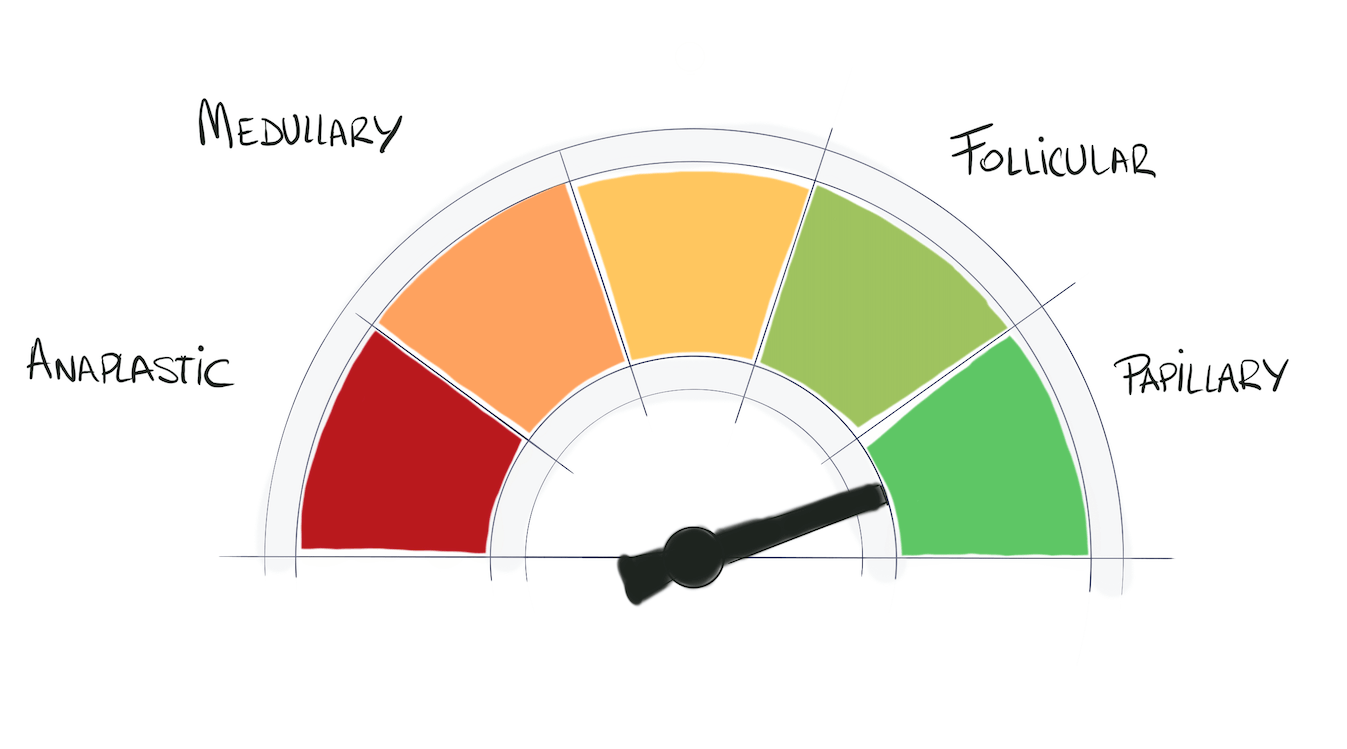
Why does thyroid cancer happen?
In most cases, we don’t find any specific cause. In some people, though, it happens because a genetic mutation: this happens to people affected with MEN 2 syndrome (Multiple Endocrine Neoplasia). They tend to have different endocrine tumors, including medullary thyroid cancer.
Apart from these mutations, there are some risk factors like diets low in iodine (typical of far mountainous regions with frequent flooding, the heavy rainfall removes iodine from the soil) and radiation. If you had radiation to your neck when you were little, there is a higher chancer for thyroid cancer.
What are the symptoms of thyroid cancer?
At first, it causes no symptoms at all. It starts as a tiny nodule inside your thyroid. It’s so small that you can’t touch it or feel it. So how do we find them? We find them accidentally, while having a U.S. test of the neck.
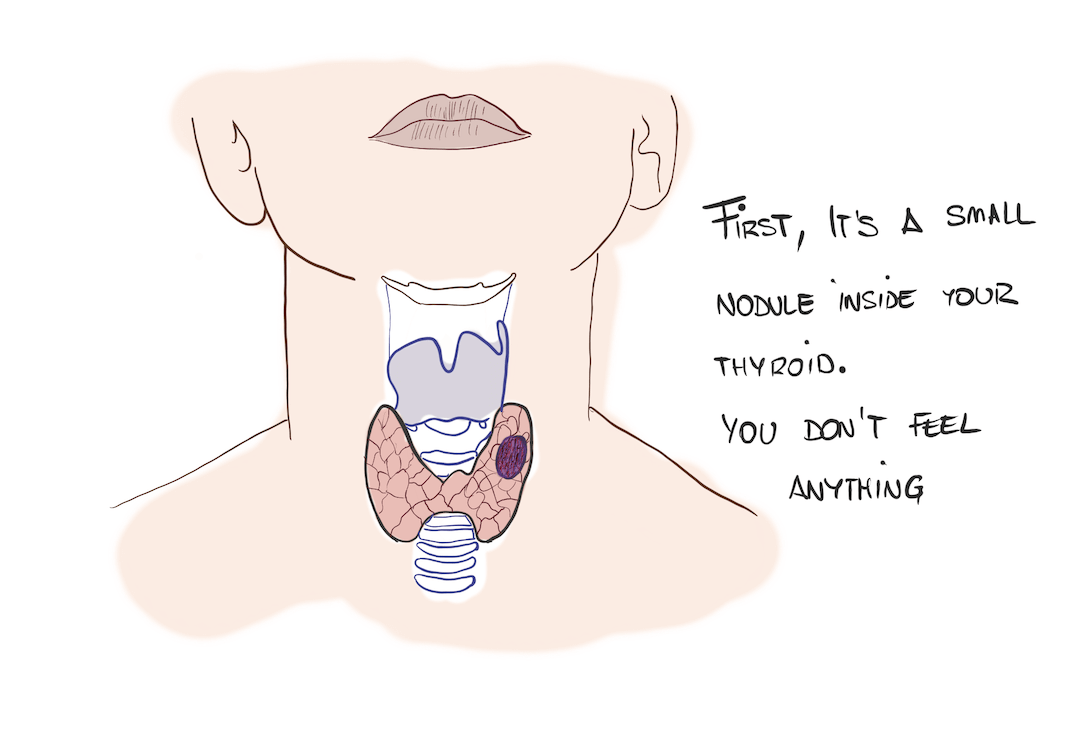
If it keeps growing, it may abut the surface of the gland and you may feel a small lump at the front of your neck.
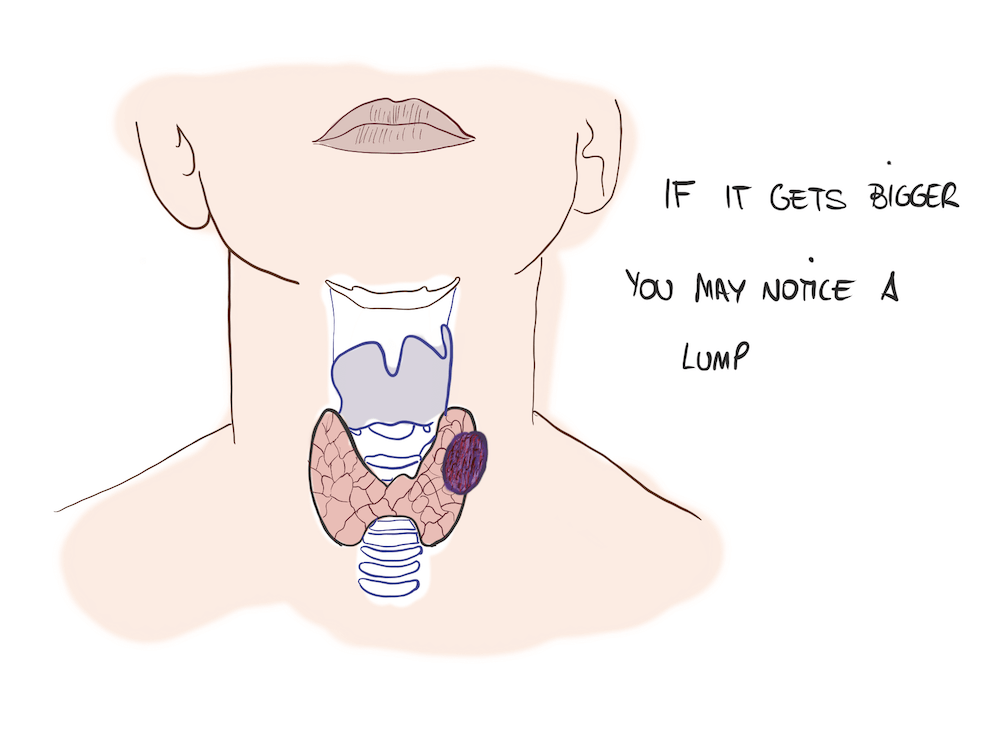
When it gets larger, it may compress some nerves in your neck, causing hoarse voice, difficulty swallowing and pain.
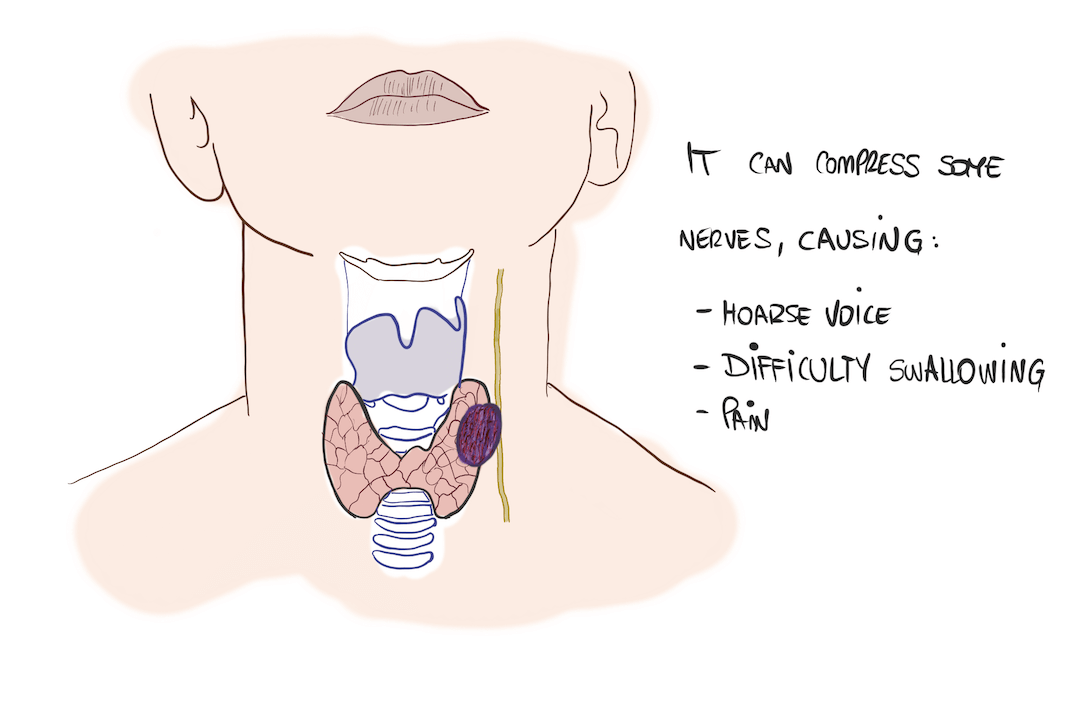
If it spreads to your lymph nodes, you may feel lumps above your clavicle.
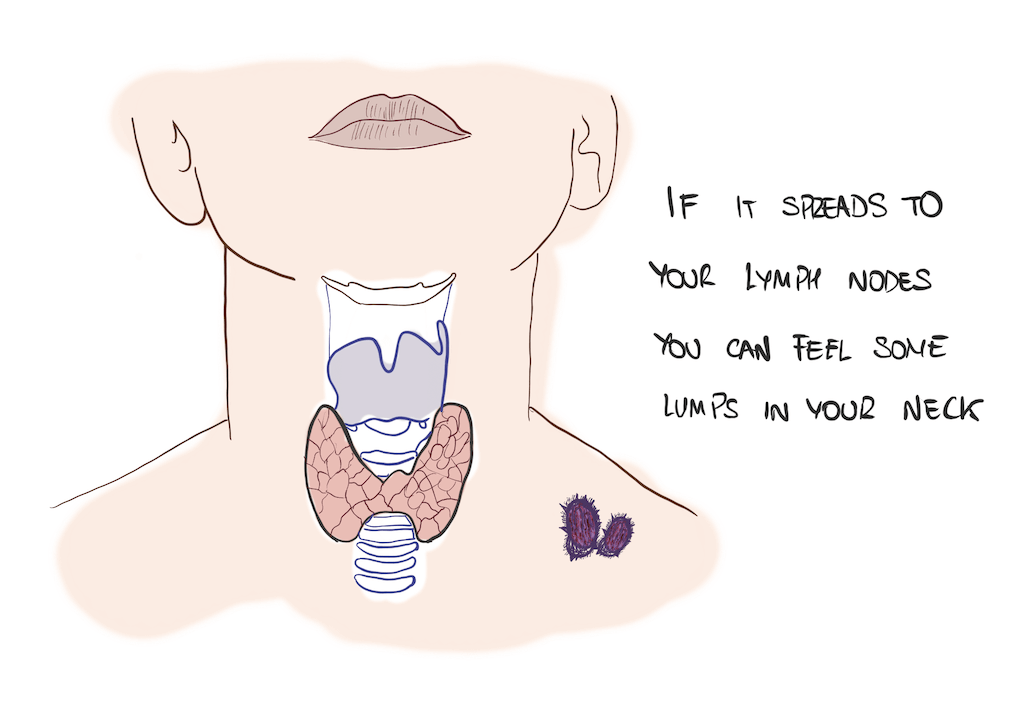
How do you diagnose thyroid cancer?
The best imaging technique for thyroid cancer is ultrasound (U.S.) because the thyroid is a shallow gland, only some millimeters deep below the skin. This is great for ultrasound, so the resolution is great. Besides, it’s harmless for the patient because it doesn’t use any radiation.
With US we can detect thyroid nodules and estimate the chances that they are cancer. For that, we use a scoring system called TI-RADS, which goes from 1 to 5. It also shows if there are any lymph nodes affected.
If we find some suspicious nodule, we need to take a sample. The ultrasound can can guide us to place the needle through the nodule. After that, we send the sample to the pathologist, who will confirm whether it’s cancer and what type.
Sometimes, the biopsy is not enough and we must remove the whole nodule to study it. It these cases, we usually remove half of the thyroid gland. The other half stays, so that the patient will still have thyroid hormones.
If you have indeed thyroid cancer, you may need a full body CT to look for metastases to your lungs, liver, bone…
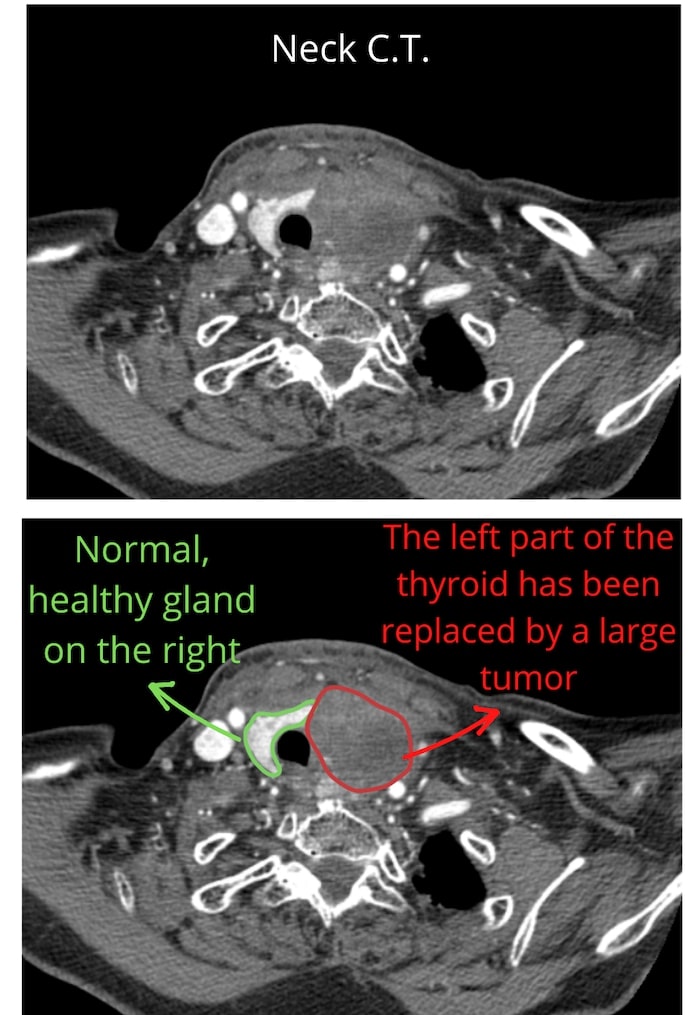
Thyroid cancer staging
Before treating cancer, it is crucial to know if it has spread.
- Is it only a small nodule or is it infiltrating other structures?
- Are there distant mets to the liver? To the lung?
Staging the tumor is very important because it will determine the prognosis and the treatment. For example, if you have a tiny nodule, surgery may be enough. On the other hand, if you have distant metastases, you will need therapies like chemotherapy or radioactive iodine.
There are 4 stages:
-
- I: the tumor is inside the gland.
- II: the tumor is “sticking its head” out of the gland.
- III: there are lymph nodes affected.
- IV: there are distant metastases.
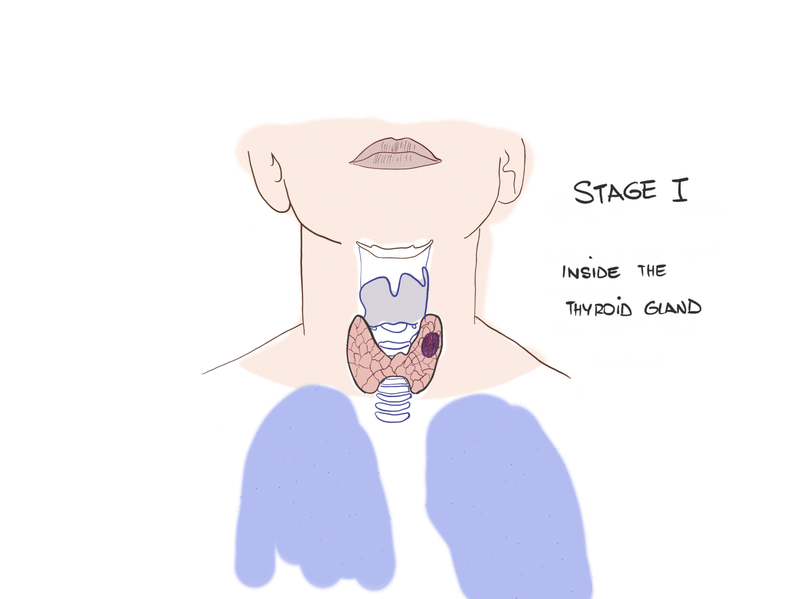
How do you treat thyroid cancer?
As we just explained, it depends on your staging. Let’s see the different options:
1 – Surgery
HEMITHYROIDECTOMY:
“Hemi” means half. “Ectomy” means removal. It means removing one half of the thyroid gland. We use it when the biopsy is not conclusive, to remove the whole nodule. Also, when the tumor is small and the patient is considered to be low risk. Keeping one half of your thyroid prevents you from taking thyroid hormone supplements.
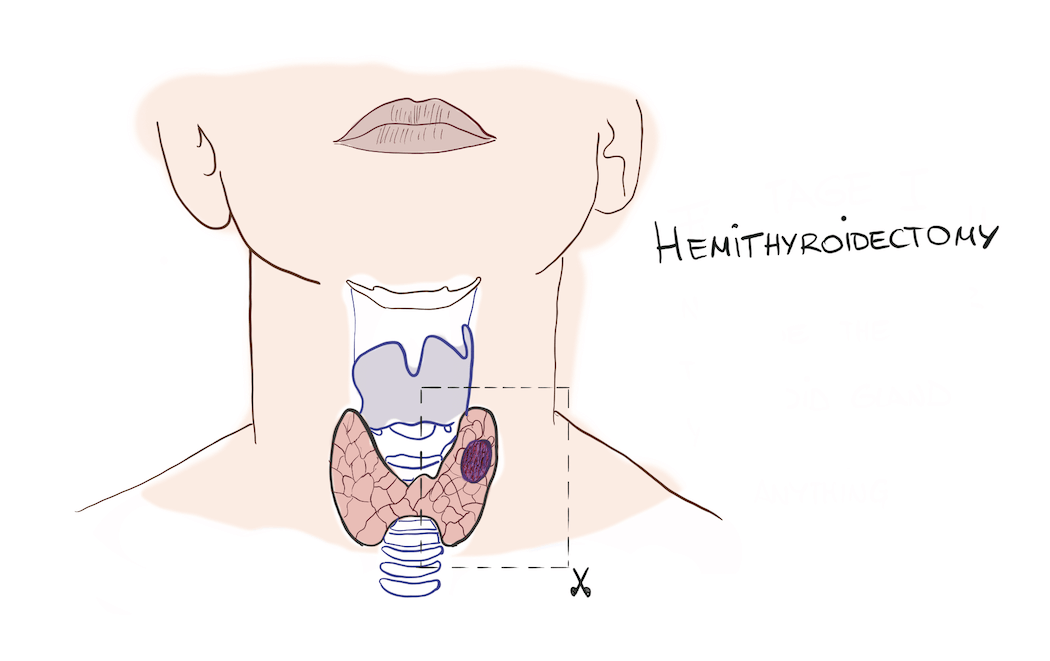
TOTAL THYROIDECTOMY:
They remove your whole thyroid gland. This is the most frequent case unless the tumor is really small. You will need to take some thyroxine supplements because you don’t have any gland left.
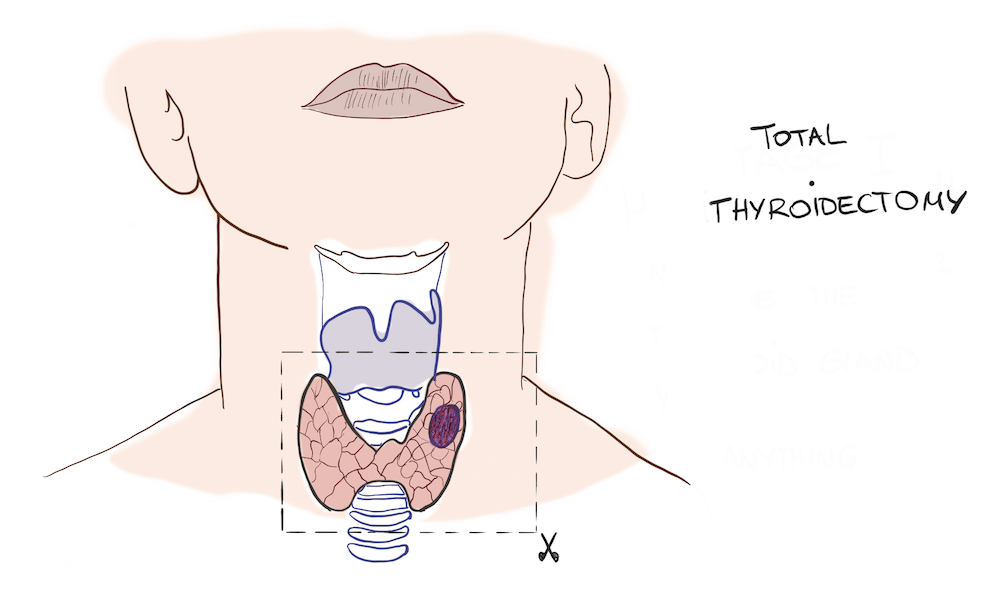
NECK DISSECTION:
While they are removing your thyroid, surgeons also check the lymph nodes in your neck. If they are affected they will remove them too. That is called lymphadenectomy, or neck dissection.
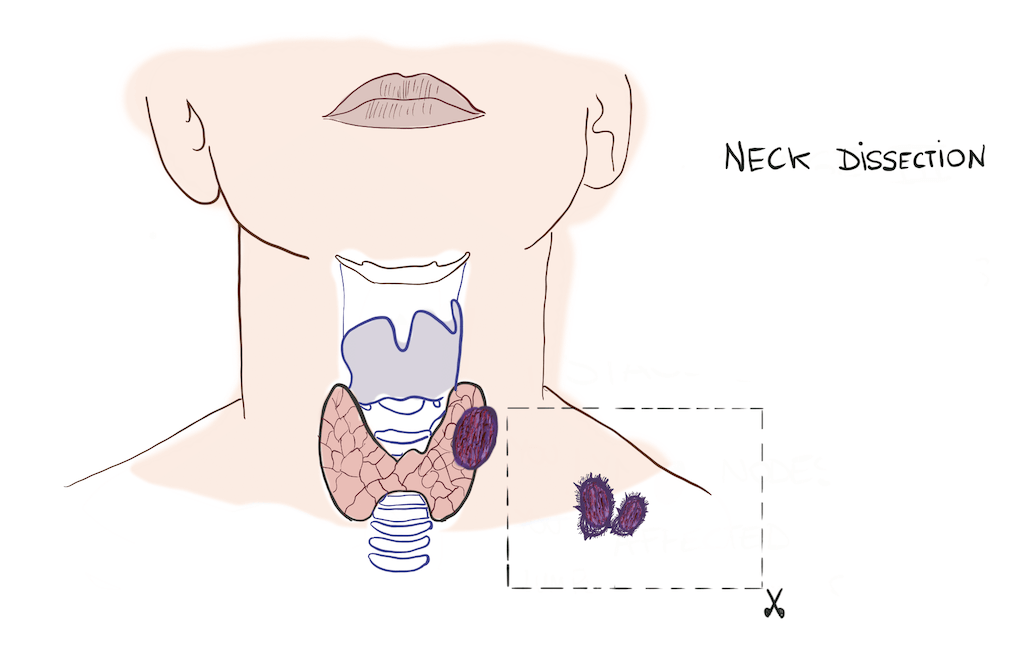
2- Radioactive iodine (RAI)
Radioactive iodine is a targeted therapy that can be used against papillary and follicular tumors (because they are well-differentiated).
Normal thyroid cells “eat” iodine molecules to produce thyroid hormone. These tumors have cells very similar to the normal thyroid. So if we give them radioactive iodine (I-131) they will take it and once they have it inside, they’ll die from radiactivity.
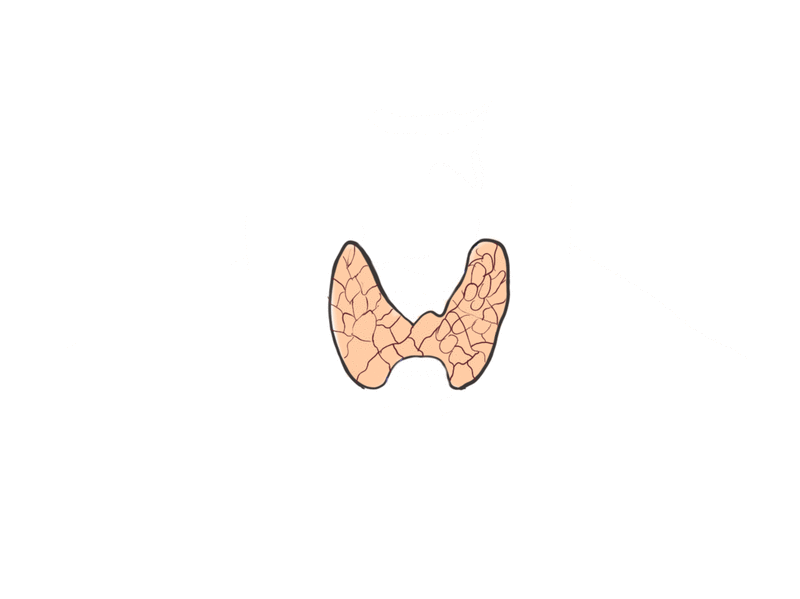
This is great for distant metastases. Imagine there is a patient with some mets in his lung. The surgeon removes his thyroid but… what can we do about the mets? We give the patient I-131, the metastases will take it and then die.
If you take this medication be careful: you will be kind of radioactive for some days. Even your pee will have some radioactive iodine in it. That’s why you will have to be admitted to the hospital and stay at an isolated special room to protect your relatives and close ones.
3 – Chemotherapy
Chemotherapy is very good for disseminated cancer. Chemotherapy travels to all your organs, where it destroys any cancer it finds.
Questions and answers
1. What happens to your body after thyroid cancer?
THYROXINE SUPPLEMENTS
If they remove your whole gland (as in 99% of cases) you will need to take some thyroxine supplements. Thyroxine is very important to regulate our body temperature, heart rate… So make sure you don’t skip your dose.
THE SCAR
The scar in your neck can hurt at the beginning, like an electricity feeling. It lasts for around 6 months, sometimes a year. But don’t worry because pain will eventually go away.
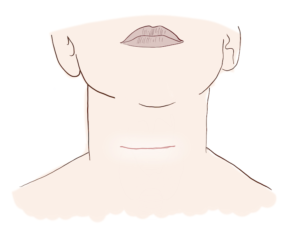
2. What’s the prognosis after thyroid cancer?
It depends greatly on the type of tumor your have and how much it has spread. Papillary tumors are slow growing and chances are pretty high that you will recover and get back to normal. Surgery is usually enough, it has a good prognosis. Even if it has spread, radioactive iodine can selectively other malignant cells that are left in your body.
On the other side, if you have anaplastic cancer (the most aggressive) it’s another story. Anaplastic tumors are very aggressive and don’t respond to RAI. So, all efforts must be focused on surgery and chemotherapy. Surgery must be as aggressive as possible, removing as much tissue as we can.
Leave a Reply